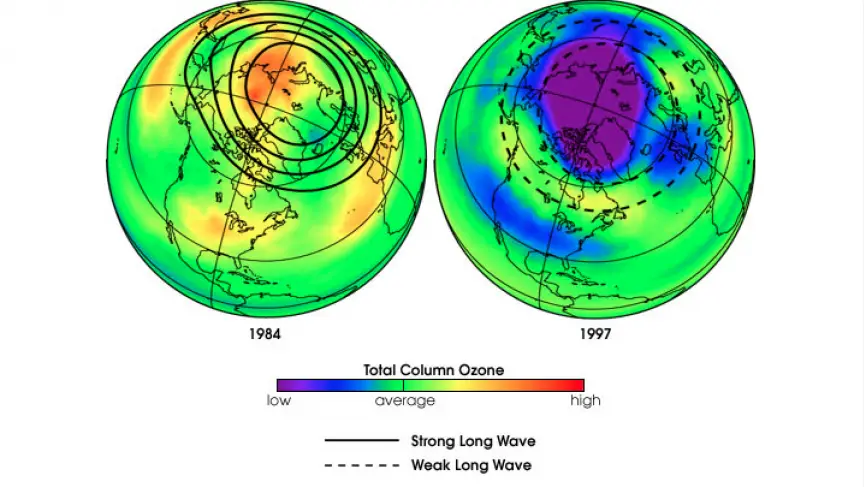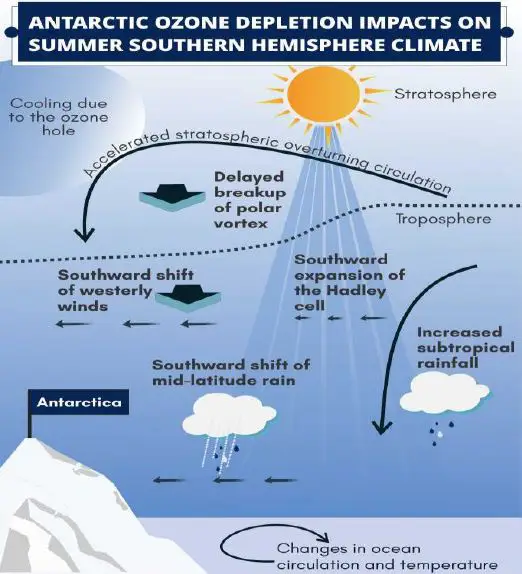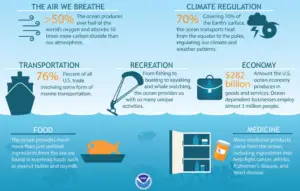Table of Contents
Scientific Assessment of Ozone Depletion | UPSC – IAS
The quadrennial (four-yearly) review of the Montreal Protocol reveals a healing ozone layer, global warming reduction potential, and options for more ambitious climate action.
Key findings of the Scientific Assessment of Ozone Depletion | UPSC – IAS
- Actions taken under the Montreal Protocol have led to decreases in the atmospheric abundance of controlled ozone-depleting substances (ODSs) and the start of the recovery of stratospheric ozone.
- The atmospheric abundances of both total tropospheric chlorine and total tropospheric bromine from long-lived ODSs controlled under the Montreal Protocol have continued to decline since the 2014 Assessment. Outside the Polar Regions, upper stratospheric ozone layer has recovered at a rate of 1-3% per decade since 2000.
- The Antarctic ozone hole is recovering, while continuing to occur every year. As a result of the Montreal Protocol much more severe ozone depletion in the Polar Regions has been avoided.
- At projected rates, Northern Hemisphere and mid-latitude ozone is scheduled to heal completely (i.e. equivalent to 1980 values) by the 2030s followed by
the Southern Hemisphere in the 2050s and Polar Regions by 2060. - The Kigali Amendment is projected to reduce future global average warming in 2100 due to hydrofluorocarbons (HFCs) from a baseline of 0.3–0.5 degree Celsius to less than 0.1 degree Celsius.
Ozone change and its influence on climate | UPSC – IAS
- Ozone is important in the climate system and its changes can influence both the troposphere and the stratosphere.
- Influence on stratospheric climate: Decreases in stratospheric ozone caused by ODS increases have been an important contributor to observed stratospheric cooling.
- New studies find that ODSs thereby contributed approximately one third of the observed cooling in the upper stratosphere from 1979 to 2005, with two thirds caused by increases in other GHGs.
- Influence on surface climate and oceans: Lower stratospheric cooling due to ozone depletion has very likely been the dominant cause of late 20th century changes in Southern Hemisphere climate in summer. These changes include the observed poleward shift in Southern Hemisphere tropospheric circulation, with associated impacts on surface temperature and precipitation.
- Changes in tropospheric circulation driven by ozone depletion have contributed to recent trends in Southern Ocean temperature and circulation; the impact on Antarctic sea ice remains unclear.
Future Global Ozone changes | UPSC – IAS
The key drivers of future ozone levels continue to be declining ODS concentrations, upper stratospheric cooling because of increased GHGs, and the possible strengthening of the Brewer-Dobson circulation (a model which attempts to explain how tropical air has less ozone than polar air, even though the tropical stratosphere is where most atmospheric ozone is produced) from climate change.
- CO2, CH4, and N2O will be the main drivers of 60°S–60°N stratospheric ozone changes in the second half of the 21st century. These gases impact both chemical cycles and the stratospheric overturning circulation, with a larger response in stratospheric ozone associated with stronger climate forcing.
- Given that ODS levels are expected to decline slowly in coming years, a large enhancement of stratospheric sulphate aerosol in the next decades would result in additional chemical ozone losses. Possible sources of additional stratospheric sulphate aerosol include volcanic eruptions (like Mt. Pinatubo in 1991) and geoengineering.
Why Montreal Protocol Worked ? | UPSC – IAS
The Montreal Protocol is one of the most successful and effective environmental treaties ever negotiated and implemented. No single factor led to its success.
- Approach of Cooperation: From the start, negotiation relied heavily on leadership and innovative approaches. Much negotiation was held in small, informal groups. This enabled a genuine exchange of views and the opportunity to take some issues on trust, such as the subsequent development of the Multilateral Fund. The people negotiating the treaty also included scientists, which lent credibility.
- Principles based: The “precautionary principle”, and the concept of common, but differentiated, responsibility took root in the Montreal Protocol when developing countries were given longer time to phase-out ODS.
- Flexibility to accommodate newer information: This flexibility meant the protocol could be amended to include stricter controls: more ozone-depleting substances added to the control list and total phase-out, rather than partial phase-out, called for. Starting out modestly also encouraged a greater confidence in the process.
- Trade Provisions and restrictions: These limited the signatories to trade only with other signatories. This increasingly limited the supplies of CFCs and other ozone-depleting substances (ODS) to non-signatories countries which forced them to ratify the Protocol.
- Clear List of Targeted Sectors: The chemicals and sectors (refrigeration, primarily) involved are clearly articulated. This let governments prioritise the main sectors early.
- Incentive to Industry: The Montreal Protocol also provided a stable framework that allowed industry to plan long-term research and innovation. Transitioning to newer, reasonably priced formulations with lower- or no-ozone depleting potential benefited the environment and industry.
- Institutional Support: Another feature of the protocol has been the expert, independent Technology and Economic Assessment Panel (and its predecessors). These have helped signatories reach solid and timely decisions on often-complex matters. They have given countries confidence to start their transition.
- The Multilateral Fund has been another reason for the protocol’s success.
- It provides incremental funding for developing countries to help them meet their compliance targets.
- Significantly, it has also provided institutional support. This helps countries build capacity within their governments to implement phase-out activities and establish regional networks so they can share experiences and learn from each other.





